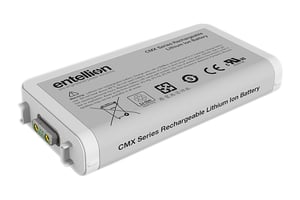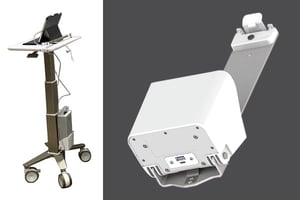~ How new batteries make transportable MedTech more fit-for-purpose ~
For over five decades, with the help of battery power, medical devices on wheels have been a cost-effective and invaluable option for hospitals. Every year new devices are introduced to the market. Fortunately, to ensure that all these old and new devices can fit around the patient's bedside, the technological advancement of various components, such as batteries, means it is now possible to design effective functionality into smaller footprints. Here, we look at MedTech on wheels throughout the decades and how new battery technologies have emerged to better serve the need for compact size and higher performance.
The miniaturisation of ventilators and anaesthesia workstations
 Most people instinctively associate the phrase "medical technology on wheels" with the larger pieces of equipment, such as ventilators or anaesthesia workstations that have been around since the beginning. In the early days, there were so few medical devices on wheels that size was not too much of an issue. However, as technology improved, new devices were introduced every decade to perform increasingly complex tasks (e.g. portable surgical robots in the 2010s). Yet, there was still only the same amount of space available around a hospital bed (around 200cm in length), so the older and larger pieces of equipment needed to be replaced by smaller versions.
Most people instinctively associate the phrase "medical technology on wheels" with the larger pieces of equipment, such as ventilators or anaesthesia workstations that have been around since the beginning. In the early days, there were so few medical devices on wheels that size was not too much of an issue. However, as technology improved, new devices were introduced every decade to perform increasingly complex tasks (e.g. portable surgical robots in the 2010s). Yet, there was still only the same amount of space available around a hospital bed (around 200cm in length), so the older and larger pieces of equipment needed to be replaced by smaller versions.
Sealed lead acid batteries were introduced in the 1970s, so were used in a lot of early mechanical ventilators, as they were the pinnacle of battery technology at the time. However, these batteries are heavy and large so made the devices equally heavy, large, and hard to manoeuvre. Therefore, in the early 2000s, Lithium-ion batteries with NMC materials were introduced, which solved this problem due to their high energy density (which means you can get the same energy for less weight and volume).
Furthermore, Lithium-ion batteries were able to offer better performance due to stable power delivery, with little variation in voltage output as the battery discharges, as opposed to sealed lead acid batteries whose power delivery dissipates during discharge. Stable power is vital to keep ventilators and anaesthesia workstations working consistently and reliably.
 That is why Accutronics introduced the Lithium-ion CMX810M. Its volumetric energy density (the amount of energy compared to its volume) is around four times greater than lead acid alternatives (181Wh/L compared to around 20-50Wh/L). It can also continuously discharge at up to 10A (or 220W) making it ideal for high power transportable devices - either as a primary power source or as a redundant backup supply.
That is why Accutronics introduced the Lithium-ion CMX810M. Its volumetric energy density (the amount of energy compared to its volume) is around four times greater than lead acid alternatives (181Wh/L compared to around 20-50Wh/L). It can also continuously discharge at up to 10A (or 220W) making it ideal for high power transportable devices - either as a primary power source or as a redundant backup supply.
The introduction of Workstations on Wheels (WoW)
Since the early 2000s, due to the growing demand for portable computing, workstations on wheels started to arrive on hospital wards. Used to transport computer systems and drug administration equipment, these sophisticated medical carts proved popular as they allowed staff to promptly tend to many medical emergencies. According to the World Healthcare Organisation (WHO), there is currently a global shortage of more than 7 million health workers, so devices that can help those in employment to work more efficiently are invaluable.
Just like ventilators and anaesthesia workstations, when workstations on wheels were first introduced, they typically used sealed lead acid (SLA) batteries as a power source, which meant they faced the same weight and performance issues as the other equipment. However, around the same time as the medical cart market started, lithium iron phosphate (LiFePO4) batteries were being developed and, in due course, became the favoured option as they are up to three times lighter than SLAs of the same energy density, which allows the overall cart to have better manoeuvrability and a more compact design. Crucially, LiFePO4 batteries also overcame the traditional lifespan problems encountered with SLAs.
 Harnessing this chemistry, Ultralife manufacture the URB-X5 external hot-swappable battery (276Wh each), up to two of which can be connected to Ultralife's X5 Power System (120VAC 60Hz) via. a docking cradle, to power devices on carts when AC mains is unavailable. Alternatively, an embeddable battery (the URB12450-U1-SMB) can be housed in the base of the cart. This battery can be used daily for around five and a half years and still deliver more than 80% of its original capacity, making it an ideal 'fit-and-forget' solution.
Harnessing this chemistry, Ultralife manufacture the URB-X5 external hot-swappable battery (276Wh each), up to two of which can be connected to Ultralife's X5 Power System (120VAC 60Hz) via. a docking cradle, to power devices on carts when AC mains is unavailable. Alternatively, an embeddable battery (the URB12450-U1-SMB) can be housed in the base of the cart. This battery can be used daily for around five and a half years and still deliver more than 80% of its original capacity, making it an ideal 'fit-and-forget' solution.
The introduction of pole/mobile carts
The tablet computer boom of 2010 saw the industry rise from 2 million tablets sold worldwide to 20 million in just 12 months. With this came a way for hospitals to reduce the size of their computer carts. Requiring around 6 times less energy than desktop computers, tablet PCs can be charged using USB-C or USB-A power rather than AC mains. Most tablets weigh under 1Kg, which is less than the smallest laptops, and have a compact profile.
 Therefore, due to this lower power demand and size, tablet computers do not require a power system or large cart but can instead be attached to a metal pole on wheels (called a pole cart) or a smaller cart. In the place where the power system would be mounted to a larger cart (or in other locations if required), the specially designed X5-LITE cradle is mounted instead. The electronic devices (e.g. laptops) are connected to the cradle using easy-to-access USB-C and USB-A ports. When the URB-X5 hot-swappable battery is inserted into the cradle, X5-LITE will use it to power connected devices.
Therefore, due to this lower power demand and size, tablet computers do not require a power system or large cart but can instead be attached to a metal pole on wheels (called a pole cart) or a smaller cart. In the place where the power system would be mounted to a larger cart (or in other locations if required), the specially designed X5-LITE cradle is mounted instead. The electronic devices (e.g. laptops) are connected to the cradle using easy-to-access USB-C and USB-A ports. When the URB-X5 hot-swappable battery is inserted into the cradle, X5-LITE will use it to power connected devices.
Medical devices on wheels are continually changing to keep up with advances in technology and get an increasingly small footprint. Leading battery manufacturers like Ultralife Corporation and Accutronics Ltd (an Ultralife company) invest in continuous research and development to ensure that the portable power sources these devices use are equally advanced, and as small and lightweight as possible.


